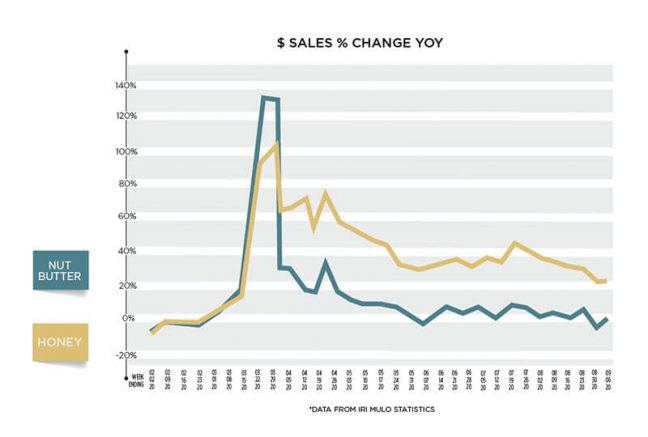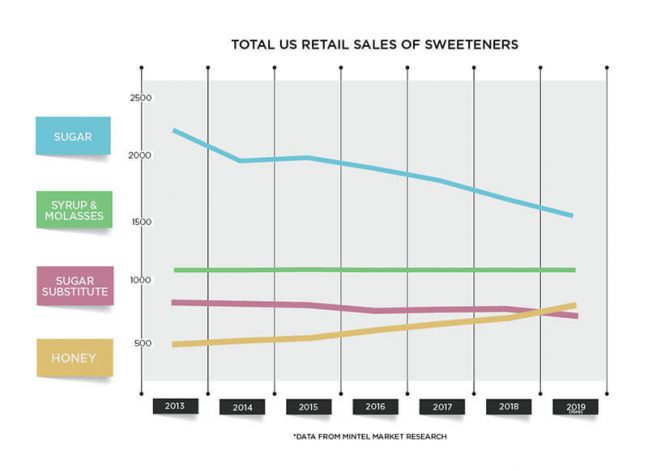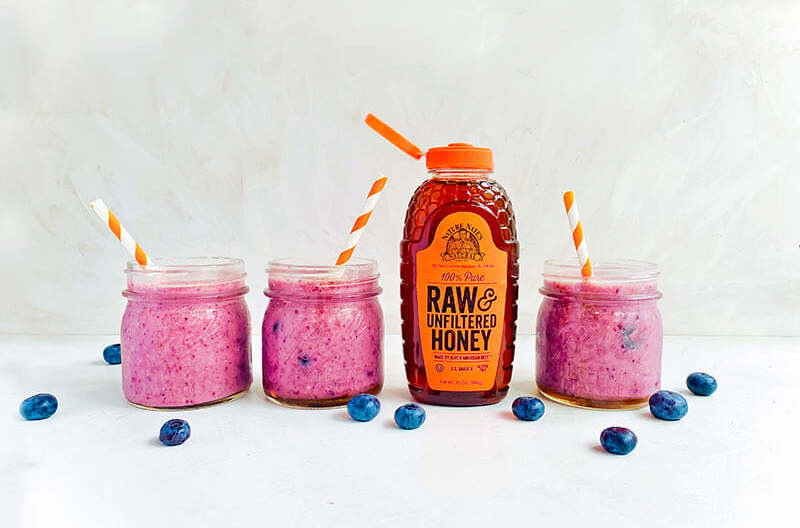Sponsored content
It’s hard to believe that honey – considered one of the oldest foods in existence – has a new life. That’s because with all of the baking, pantry stocking and kitchen experimenting associated with life in the days of COVID-19 and beyond, honey is flying off of the shelves, into shopping carts and going home with more shoppers than ever before.
Rising beyond a commodity
The demand for pure, real honey isn’t a surprise. Over the past decade, grocers have seen an influx of brands revitalizing goods that were once considered basic commodities. Vital Farms set a new standard for eggs and butter. Kodiak Cakes flipped the boxed pancake category upside down with protein. The consumer demand is clear: Shoppers are looking for  added value, purity and transparency in the products they buy.
added value, purity and transparency in the products they buy.
When it comes to honey, consumers are not only looking for pure, real honey but also increasing their usage beyond a typical cup of tea. Before the coronavirus pandemic, one-third of households were regular honey users. Since the impact of the pandemic on everyday life, now half of households use honey consistently, and they aren’t slowing down.
While other food categories have returned to traditional levels of consumption, the honey category is still steadily experiencing sales that are more than 20 percent higher than the same period last year (IRI MULO, Total US, Honey Report), and Nature Nate’s 100 percent pure raw and unfiltered honey continues to lead the category as the nation’s No. 1 branded honey.

The search for something natural
So, why has honey experienced such an increase? New consumers are definitely to thank. Those who previously used sugar in their tea, coffee and even smoothies have switched to honey, because it’s an all-natural sweetener. In fact, honey is the only sweetener that has been growing in preference year over year. It remains only second to processed sugar and remains ahead of non-calorie sweeteners on the market. As for those coffee, tea and smoothie drinkers, their use of honey has increased 7 percent year over year – a significant category leap, according to the National Honey Board Consumer A&U Report, 2019.

Existing honey consumers have also contributed to the category’s growth, using honey more often and in innovative ways. They believe that raw and unfiltered honey has more benefits than taste. When it comes to soothing a sore throat, 78 percent of honey users believe that honey can help, according to various recently published studies. Another 53 percent also believe that honey is a good source of energy. In addition, a recent medical study by Oxford even revealed that “honey was superior to usual care for the improvement of symptoms of upper respiratory tract infections” and that honey “provides a widely available and cheap alternative to antibiotics.”
Swapping out processed sugar for premium honey
Shockingly, about 10 percent of Americans get over 25 percent of their daily calories from processed sugar, which has no added nutritional value. The urgings of a sweet tooth are hard to ignore; however, consumers aren’t completely sacrificing their cravings – they are switching to all-natural honey.
Pure, raw and unfiltered honey contains nutrients and enzymes, meaning it isn’t a source of “empty calories” like processed sugar or high fructose corn syrup. And people process honey differently than processed sugar, making the dreaded “sugar crash” a distant memory.
How consumers are using honey
Honey is traditionally used to pour onto oatmeal or into green tea, but today’s consumers are realizing more and more that honey is an extremely versatile sweetener. Consumers are using honey in their new-found baking hobby, in at-home hot and iced coffees and as a sweetener for mixed drinks.
It’s becoming a favorite pairing to start the day with a wholesome breakfast and as a natural pick-me-up in the afternoon for kid and adult snacking. Honey is also being used in the evening as an added flavor in homemade dressings and glazes and better-for-you bites in desserts, from cookies to brownies and ice cream.
Purity is everything
It’s clear that today’s grocery shoppers are savvier than ever before, and they want to know what they’re eating. When consumers choose Nature Nate’s pure honey, they’re selecting a national award-winning flavor profile that is without any fillers or additives. Consumers also have the confidence in Nature Nate’s strict testing standards that ensure every bottle is as simple and pure as it is straight from the hive.
COVID-19 continues to impact grocery as consumer behavior adapts to a new way of life. Consumers are spending more time at home, and much of this new-found time is spent in the kitchen trying new, better-for-you foods, enjoying new hobbies like baking and mixology and eating more meals at the table together. Honey is becoming a mainstay in all these growing trends, and whether in store or online, grocers have the opportunity to grow the dollar value of consumer shopping carts with 100 percent pure, raw and unfiltered honey.

